Updated Dec. 10, 2023. Wandering around Lisbon’s streets, you never know what you will find; perhaps medieval history, street art, or a house covered in ceramic tile. With thousands of tiled facades, Lisbon’s tiled houses are a tradition that you will love.
This article points out some of the more famous tiled houses, as well as some of the more obscure ones, gardens and museums that feature Portuguese tile, and the workshops that make and sell the tile today.
Lisbon’s tiled houses
Lisbon’s tiled houses are made out of azulejos. Azulejo comes from Arabic and means “polished-stone.” Azulejos were introduced in Portugal by the Moors, and then later King Dom Manuel I, used them to decorate the National Palace in Sintra.
Originally the tiles were made of clay. Today, a glazed ceramic tile is used.
The Morrish tiles were mostly interlocking geometric shapes, with some flower patterns.
Dutch and Portuguese artists began to tell stories, often religious, in their mosaics.
Why do Lisbon’s buildings have tiled façades?
At first, ceramic tiles were used mostly indoors by wealthier people, but by the 18th century became extremely common as an exterior finish. This is due to the fact that they are weather resistant and long-lasting. The tiles also help homes stay cool during hotter months.
Following the 1755 earthquake, there was a great demand for azulejo tile, and by this point they were being mass-produced.
In the 1950s, Lisbon began putting tiles in the metro stations. You can find some great artwork there as well.
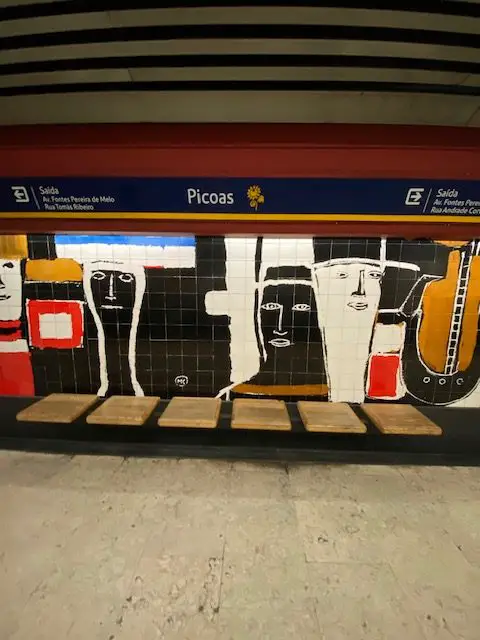
Where to find the best tiled houses in Lisbon
Tiled façade at Largo do Intendente, 26
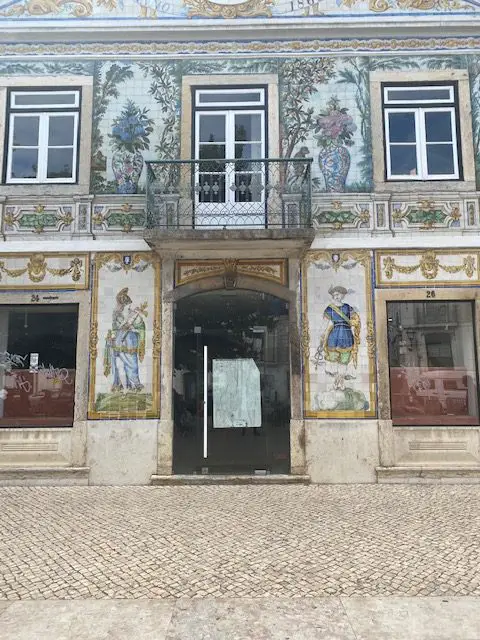
Fábrica Viúva Lamego is located on the Largo do Intendente plaza, near the Intendente metro station (green line). It is a few hundred meters back from the street, and you will pass by several cafes and restaurants on the way to the shop.
Built in 1865, this building was originally the pottery workshop of António Costa Lamego. The tiled facade depicts leaves, and jars. monkeys, and Chinese figures, hinting at Portugal’s history of exploration.
Today visitors can go inside and purchase tiles and pottery. Also, next door you will find A Vida Portuguesa – one of the best shops to find locally made souvenirs. For more information see my Lisbon’s historical family-owned stores and craftsmen sell the best souvenirs
Old tiled façade on Avenida Almirante Reis
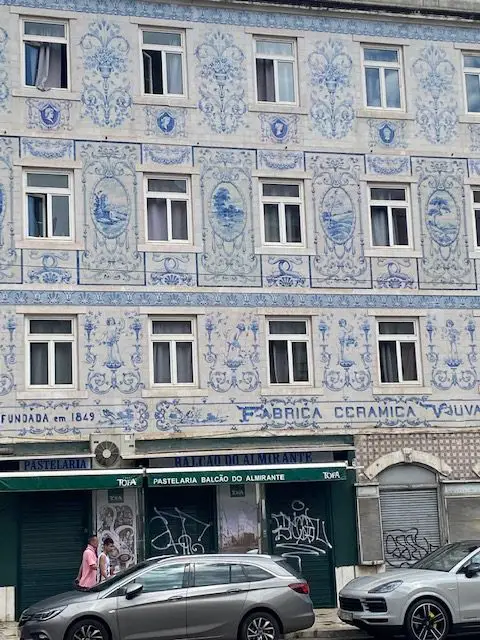
The Viúva Lamego Ceramic shop was founded in 1849. The blue and white designs on this building at Avenida Almirante Reis were created by the factory’s artistic director, Luís António Ferreira.
Many of the tiles found in Lisbon were produced in this shop. The current Viúva Lamego factory is located in Sintra.
Tiled house at Campo de Santa Clara
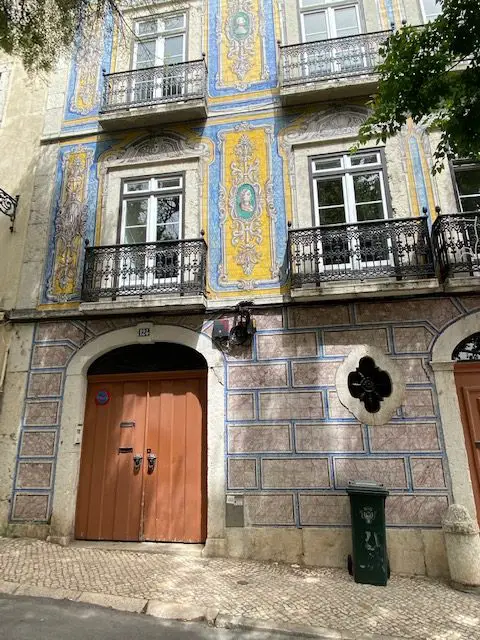
This tiled building near the Feira de Ladra (flea market) and the National Pantheon was built in 1860.
One of Lisbon’s most beautiful houses, you can stay in it, as today it houses the Casa dell’ Arte Club House Hotel. The interior is as impressive as the exterior. To book: https://www.booking.com/hotel/pt/casa-dell-39-arte-club-house.en.html?aid=7930224&no_rooms=1&group_adults=2
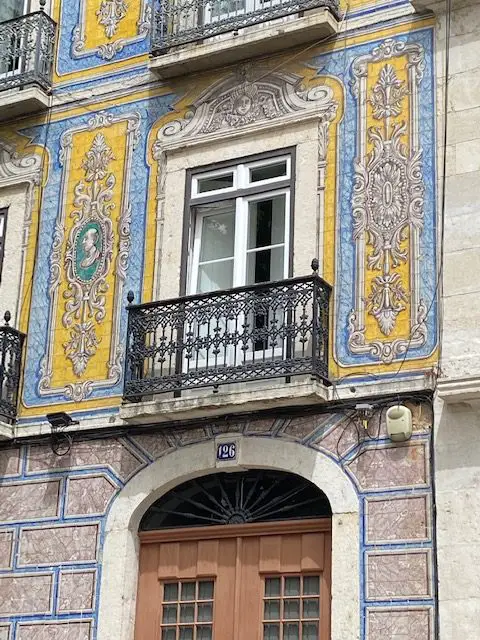
Casa do Ferriera das Tabuletas
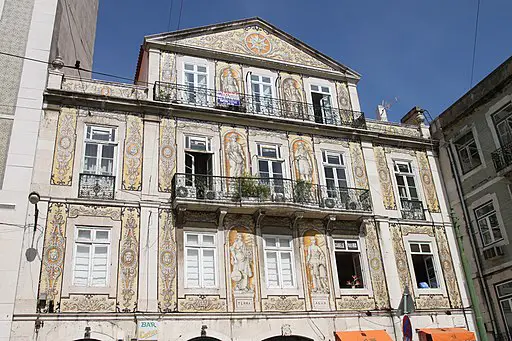
Built in 1864, the tile facade was created by artist Luís António Ferreira, the director of the Viúva Lamego Tile Factory.
The house was built by Manuel Moreira Garcia, owner of Cervejaria Trinidade. The house is also known as the Rafael Bordalo Pinheiro House, as the artist lived there until he died in 1905.
The house is near the Convento do Carmo ruins, and is located at Rua da Trinidade, 32. Casa do Ferreira das Tabuletas is one of the most photographed houses in Lisbon.
Pastelaria Santo António’s beautiful tile façade

Rua do Milagre de Santo António, 10 -14
The mosaics on the second floor depict three miracles of St. Anthony, who grew up in the neighborhood.
Not just one of the best tile façades in Lisbon, if you come by this bakery just below the castle, you can also sample what might be the best pastel de nata in Lisbon. These treats cost $1.25 each.
To learn more about this Portuguese custard tart and try to decide for yourself who has the best in Lisbon, read my article The big difference between Pastéis de Belém and Pastéis de Nata
Rua do Possolo, 76
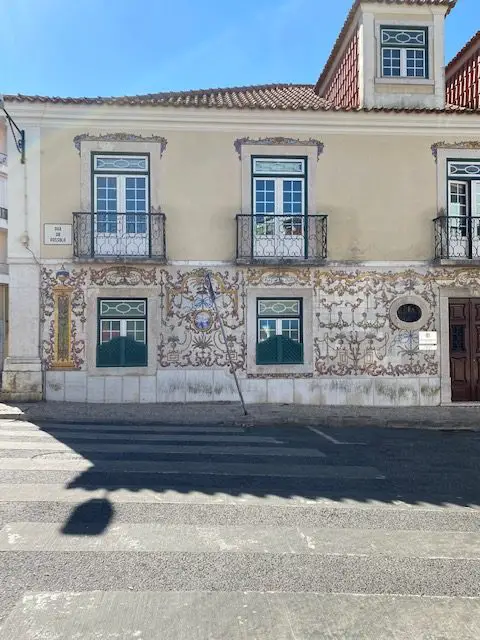
Rua do Possolo, 76 is currently home to the Embassy of Finland and the Embassy of Andorra.
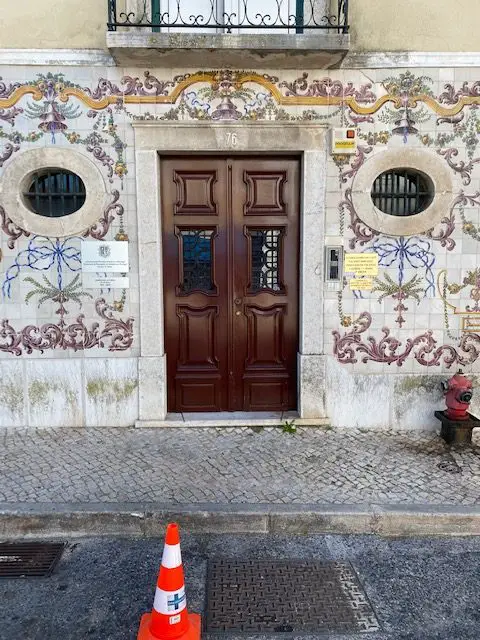
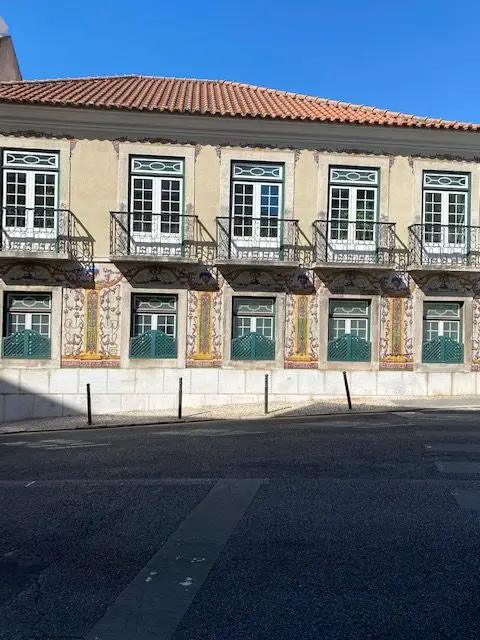
Berardo Art-Deco Museum
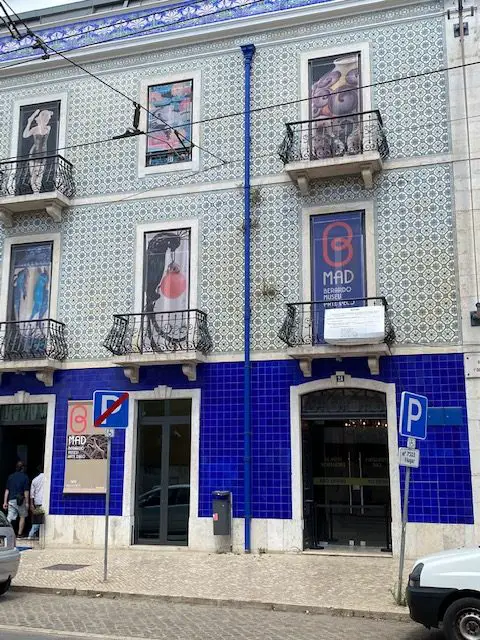
The Berardo-Art Deco Museum currently resides in the former summer residence of the Marquêes de Abrantes (seen above).
The museum is one of the newest in Lisbon (2022), and is one of the best values in the city. Admission is only 5€ and includes a free wine tasting.
It is located in the Alcântara neighborhood, within a block of the LX Factory and the 25th of April Bridge.
Other beautiful tile façades in Lisbon
There are thousands of houses and shops outfitted in tile in Lisbon. Here are some that I really like.
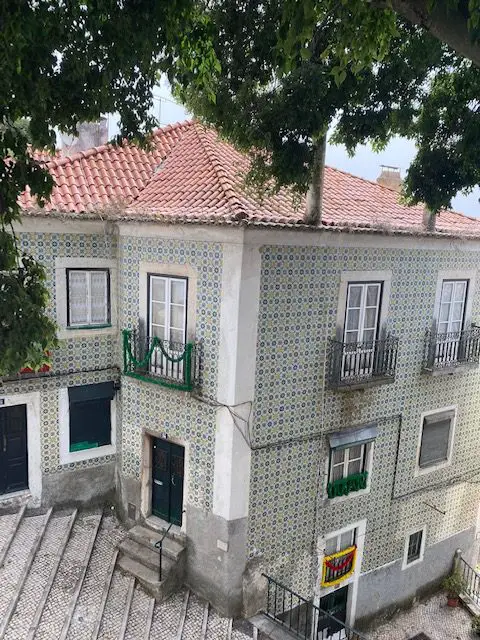
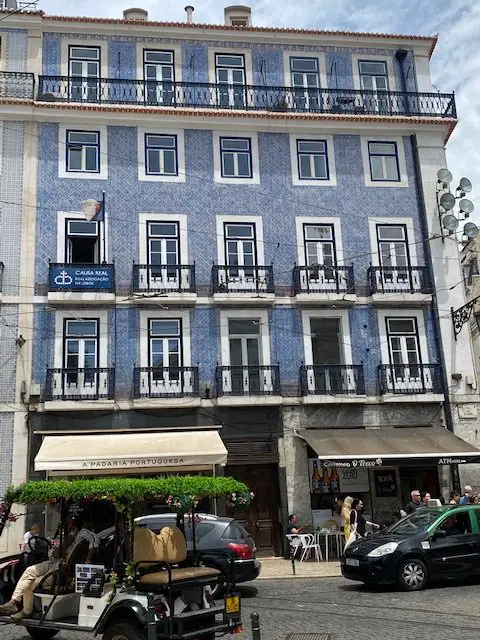
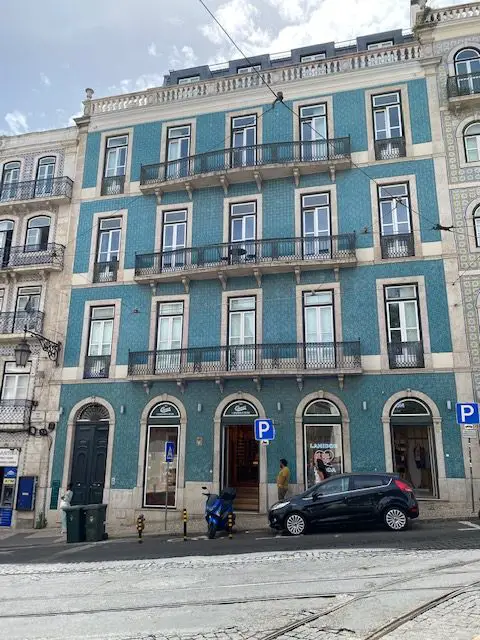
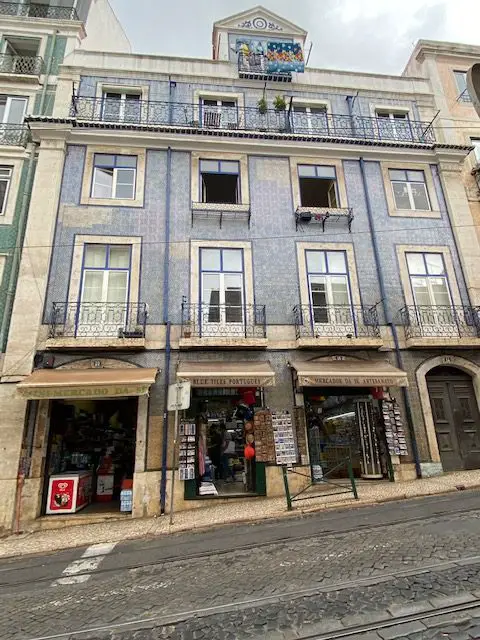
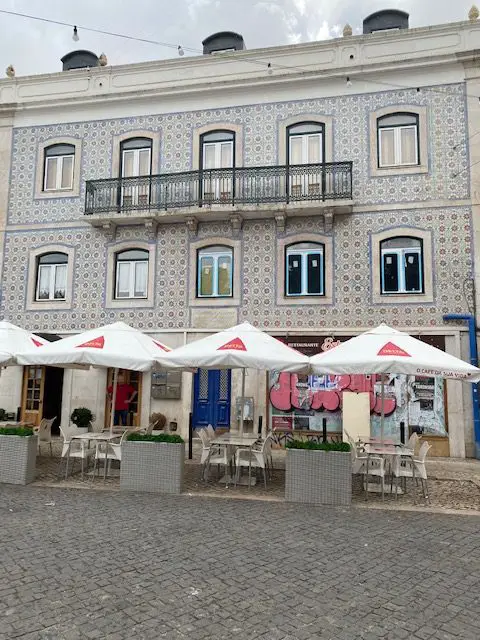
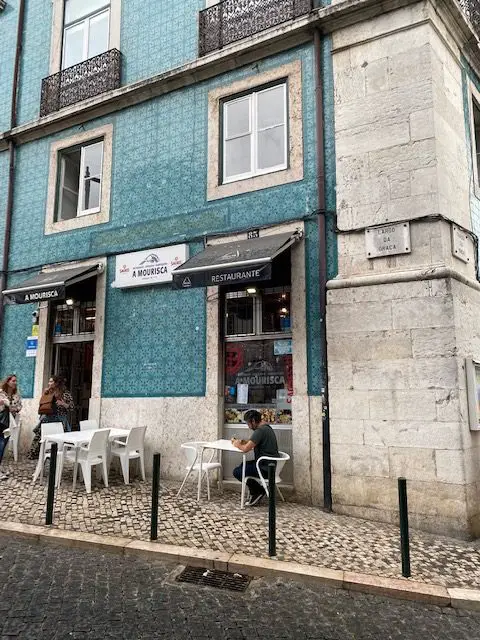
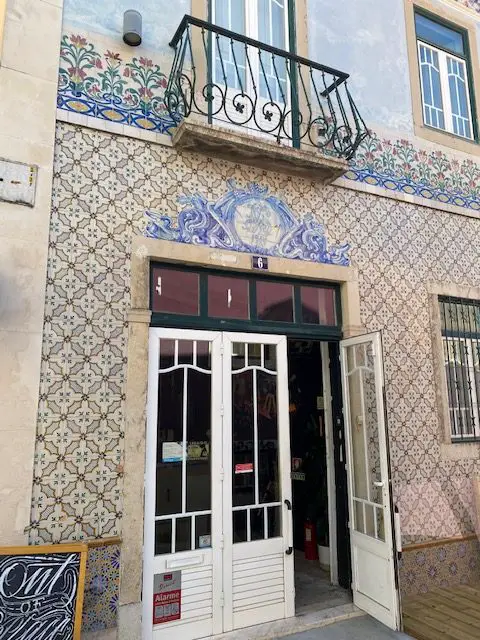
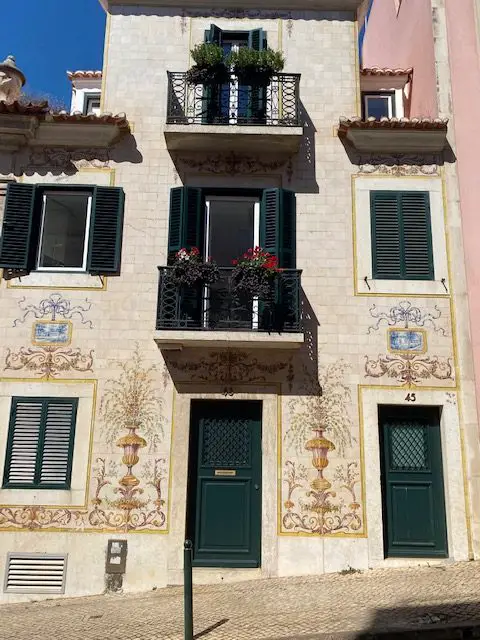
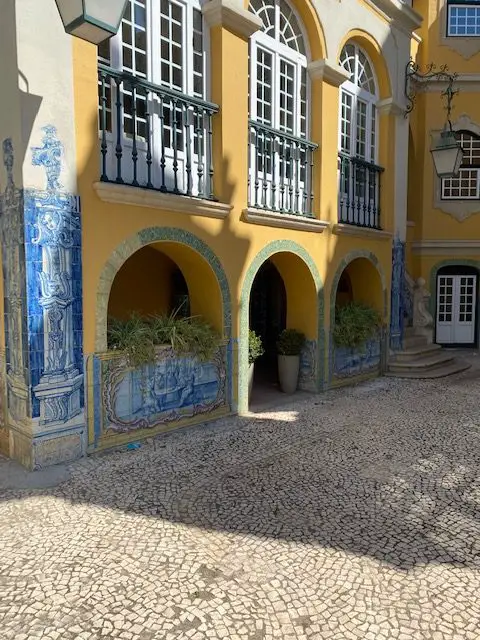
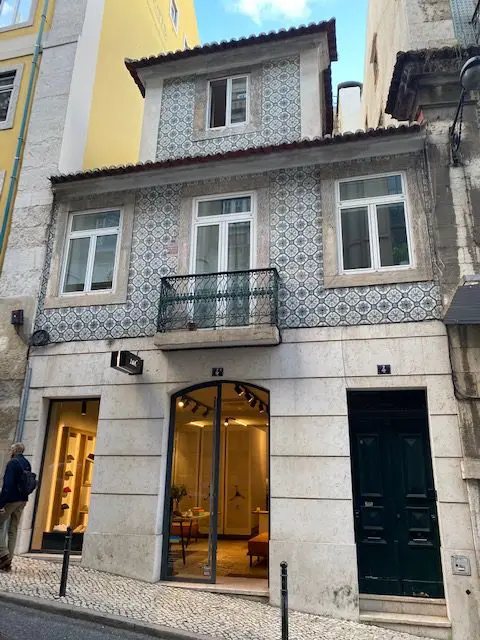
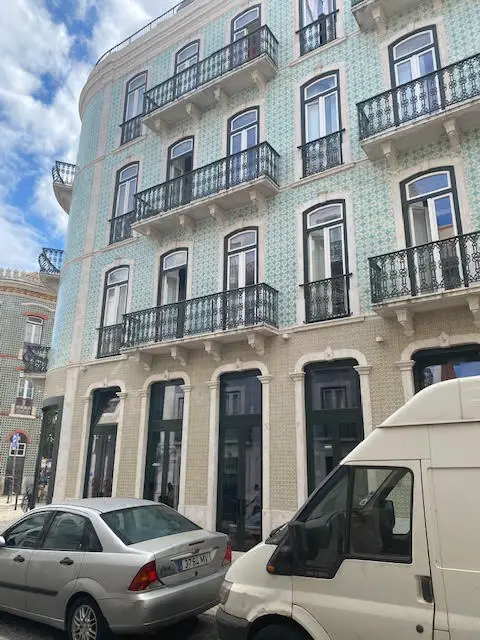
Not tiled facades, but if you like azulejo tile you must see –
Mosteiro de São Vicente de Fora

This monastery in Alfama has more than 10,000 pieces of azulejo tile. Much of the interior, as well as the cloisters are decorated in azulejo tile, and upstairs you will find panels that narrate LaFontaine’s Fables.
Visitors can also step out on the roof and enjoy views of the river and the Alfama neighborhood. Admission to the monastery is 5€. For more information, read my Visit São Vicente de Fora in Lisbon: Everything you need to know
Palácio dos Marqueses da Fronteira in the Benfica neighborhood
This palace, which is currently occupied, is open Monday – Friday from 10 am – 6 pm. Visitors can take limited tours of the interior. Much of the tile can be seen on the grounds of the 17th -century palace and in the gardens. Official website: https://www.casadomarques.pt/palacio-marqueses-de-fronteira/
National Tile Museum
Lisbon’s National Tile museum thoroughly details the 500 years of tile as an art form and how it has evolved over the centuries. The museum has panels that depict Lisbon before the 1755 earthquake, and also has a beautiful collection of contemporary tile art.
The museum is located in the former Convento da Madre de Deus, and visitors are able to enjoy its chapel – which might be one of Lisbon’s prettiest churches – completely done in blue and white azulejo tiles and dark Brazil wood.
For more information, read my, National Tile Museum in Lisbon | A Quick Guide
Jardim da Quinta dos Azulejos
This secret 18th century garden is filled with tiled benches, fountains, aches, and angels. It is located in north Lisbon, near the Estadio da Luz. The closest metro station is Carnide (blue line). To see photos of this garden, go to Jardim Quinta dos Azulejos (acasasenhorial.org)
Tiled façades in the city of Porto
If you like azulejo tile, it is worth the trip to Porto in the north of Portugal. It is an easy trip on the Comboios do Portugal train.
The São Bento Railway station in the center of Porto is magnificent. You will also find several churches in the city center that have been done from top to bottom in blue and white azulejo tile.
Where can you buy Azulejos?
Lisbon has lots of different souvenir shops that sell azulejos for between five euros and €20 per tile.
You can also buy directly from wholesalers or craftsman. You can check some of the different shops such as:
Fabrica Sant’ Anna
The oldest tile workshop in Europe, has been hand-painting tiles since they opened prior to the 1755 earthquake.
Everything they do is hand-painted and unique.
You will find an assortment of tiles, panel projects, pottery and handmade dishes in their showrooms.
Open every day from 9:30 until 6pm, the craftsmen are happy to show you around their workshop.
Contact them through their website in order to arrange a three-hour pottery / tile class.
Calçada da Boa-Hora 96 (workshop and showroom) in the Boa-Hora neighborhood, north of Belém, or Rua do Alecrim, 95 near the Baixa-Chiado metro station.
http://www.santanna.com.pt/en/
Cortiço e Netos – Cortiço and Grandsons
Joaquim Cortiço collected Portuguese tiles between 1979 and 2013. Most of the tiles in his collection are from the 1960s and onward, and most of the manufacturers have since shut down their workshops, or the designs have been discontinued.
Although they are all modern, these pieces are the last available from many of the artisans. Rua Maria Andrade, 37D. Home — Cortiço e Netos (corticoenetos.com)
If the tiled facades of Lisbon appeal to you, I will bet that you also love the Portuguese pavement: Black and white cobblestones in Lisbon
Thank you for reading about Lisbon’s tiled houses on my website. If you purchase anything from a link on this page, I will earn a small commission. Thank you for supporting my work. Thank you for reading about Lisbon’s tiled houses on my website.